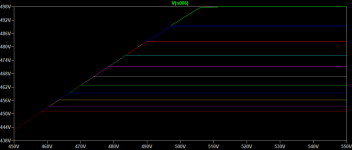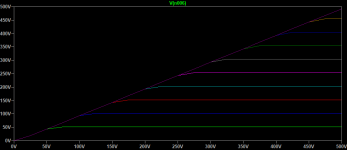Tom has had part of his design ripped off for commercial use so most would be hesitant to give you this information. I wouldn't take it personally, if you email Tom, he might help you with some values. Are you trying to adjust nominal voltage? If so, experiment with R9 values until you get the results.
Let's do this again, here are two examples of stepping either R4 from the original schematic, a 5K potentiometer from 1 ohm to 5k in 500 ohm steps, the second image is stepping R9 from 50k to 500k in 50k steps.
Attachments
Just ordered one from the neurochrome website. I plan to use it for the B+ in a 300B OTL headphone amp, a scratch build of the Transcendent 'Masterpiece' pre-amp. Output requirement (for both channels) will be circa 200mA at 150V.
@tomchr
I have a quick question about how much ripple is acceptable into the new maida project you have published. The documentations point out the drop out voltage is 15v and this includes effects of ripple voltage.
I suppose my question is, if we compared a very large amount of capacitance before the regulator to one that just met the minimum guidance above, would the regulator perform the same, in terms of quoted specs of residual noice and hum?
I'm considering using no electrolytic caps before the regulator and this means I'm limited to how much capacitance I can cram in. My goal is to reduce 60Hz and multiple harmonics in my project.
I have a quick question about how much ripple is acceptable into the new maida project you have published. The documentations point out the drop out voltage is 15v and this includes effects of ripple voltage.
I suppose my question is, if we compared a very large amount of capacitance before the regulator to one that just met the minimum guidance above, would the regulator perform the same, in terms of quoted specs of residual noice and hum?
I'm considering using no electrolytic caps before the regulator and this means I'm limited to how much capacitance I can cram in. My goal is to reduce 60Hz and multiple harmonics in my project.
What is the 85dB relative to? So I guess the question is still what’s the maximum ripple I should aim for before the regulator, to keep it performing best?
?????????to keep it performing best?
This is incomprehensible for me.
If you want -for example- 1mV ripple on- for example 400V- output of Maida II regulator, the maximum allowed ripple on input is about 12.5V (unrealistic 🙂 ).
?????????
This is incomprehensible for me.
If you want -for example- 1mV ripple on- for example 400V- output of Maida II regulator, the maximum allowed ripple on input is about 12.5V (unrealistic 🙂 ).
So, if 12.5V ripple on input equals 1mV ripple on output, then what does 1mV ripple on input result in? 1mV? 1uV?
What I mean by “best performance” is how sensitive is the overall regulator performance to the ripple on its input. If I can have 1uF across the bridge on the input or need 1000uF across the bridge and both result in the same noise on the output, that would be handy to know.
In other words, what does the regulator need as input to ensure it performs the best it can and when does input bridge capacitance reach law of diminishing returns.
If you had checked the LT3080 datasheet, the output noise is about 100uVpp, so under this voltage the "ripple rejection" is usually invisible.
85dB= 20*log(Uin_ripple / 100uV)
Uin_ripple is about 1.8Vpp.
85dB= 20*log(Uin_ripple / 100uV)
Uin_ripple is about 1.8Vpp.
@tomchr
I have a quick question about how much ripple is acceptable into the new maida project you have published. The documentations point out the drop out voltage is 15v and this includes effects of ripple voltage.
I suppose my question is, if we compared a very large amount of capacitance before the regulator to one that just met the minimum guidance above, would the regulator perform the same, in terms of quoted specs of residual noice and hum?
I'm considering using no electrolytic caps before the regulator and this means I'm limited to how much capacitance I can cram in. My goal is to reduce 60Hz and multiple harmonics in my project.
Sorry for the very belated response here. Somehow the notification emails for this thread stopped coming, so I missed it.
Going without any capacitor in front of the Maida Regulator is not a good idea.
In my DG300B, I have 50 uF in front of the Maida. That results in about 50 Vpp of ripple voltage on the input of the Maida. The output shows 20 µV of ripple+noise.
Tom
Fair enough. This thread was actually started before I started my business. Time flies. By now it certainly belongs in the Vendor's Bazaar. 🙂
As many of you have observed, I am discontinuing many of my vacuum tube circuits, including: Universal Filament Regulator, DG300B, and Novar Spud. I just wanted to take this opportunity to make it clear that the 21st Century Maida Regulator is still going strong and I plan to keep it going for a long time to come.
Thanks,
Tom
As many of you have observed, I am discontinuing many of my vacuum tube circuits, including: Universal Filament Regulator, DG300B, and Novar Spud. I just wanted to take this opportunity to make it clear that the 21st Century Maida Regulator is still going strong and I plan to keep it going for a long time to come.
Thanks,
Tom
Joe Curcio's regulator vs. 21st Maida
Hello Tom.
Way upfront you mentioned Joe Curcio's regulator. I have a pair in my Dynaco Mk 3's regulating the B+ to the opt center tap only (not the screens; I'm in triode mode) in that pp kt88 circuit. The driver board is separately regulated.
Do you think I'll have much improvement if I install the 21st Century Maida? My high efficiency speakers run at about 1 watt. I have plenty of uF (175) in the clc preceding the regulator as presently installed. The bias is zener regulated. There is no audible hum.
Any input would be appreciated.
Thanks for this great thread.
Hello Tom.
Way upfront you mentioned Joe Curcio's regulator. I have a pair in my Dynaco Mk 3's regulating the B+ to the opt center tap only (not the screens; I'm in triode mode) in that pp kt88 circuit. The driver board is separately regulated.
Do you think I'll have much improvement if I install the 21st Century Maida? My high efficiency speakers run at about 1 watt. I have plenty of uF (175) in the clc preceding the regulator as presently installed. The bias is zener regulated. There is no audible hum.
Any input would be appreciated.
Thanks for this great thread.
Funny you mention Joe Curico. I met him years ago while we both were still working for National. Nice guy.
Joe's regulator uses an opamp that floats on top of the B+ supply. I tried that many moons ago and found its regulation to be so-so as hum tended to creep in through the reference voltage. Thus, I suspect you'll see some improvement (firmer bass) with my Maida Regulator.
Tom
Joe's regulator uses an opamp that floats on top of the B+ supply. I tried that many moons ago and found its regulation to be so-so as hum tended to creep in through the reference voltage. Thus, I suspect you'll see some improvement (firmer bass) with my Maida Regulator.
Tom
Joe Curcio's regulator vs. 21st Maida
Thanks Tom.
If you look at the schematic here: http://www.curcioaudio.com/paregsch.gif you can see that only the screen is floating an op amp. the "plate out" which I am considering replacing seems similar to your 21'st century maida. Am I missing something?
Thanks Tom.
If you look at the schematic here: http://www.curcioaudio.com/paregsch.gif you can see that only the screen is floating an op amp. the "plate out" which I am considering replacing seems similar to your 21'st century maida. Am I missing something?
Ah! You're right. You'll probably get a little better performance as my 21st Century Maida Regulator uses more modern parts, but whether the slight performance difference is worth the hassle of swapping out the regulator is up to you.
That said, adding the 21st Century Maida Regulator would be pretty easy. Just pluck a few parts from the existing circuit to remove the old Maida and connect up the 21st Century one.
Tom
That said, adding the 21st Century Maida Regulator would be pretty easy. Just pluck a few parts from the existing circuit to remove the old Maida and connect up the 21st Century one.
Tom
Thank you Tom.
Any advice on how to go about optimizing the capacitor on the output?
thanks again
Any advice on how to go about optimizing the capacitor on the output?
thanks again
On the 21st Century Maida Regulator, I recommend staying at or below 47 uF on the output. I normally put 10 uF for decoupling and leave it at that. Let the regulator do its job.
Tom
Tom
- Home
- Vendor's Bazaar
- 21st Century Maida Regulator


 Thread moved to Vendor's Bazaar.
Thread moved to Vendor's Bazaar.